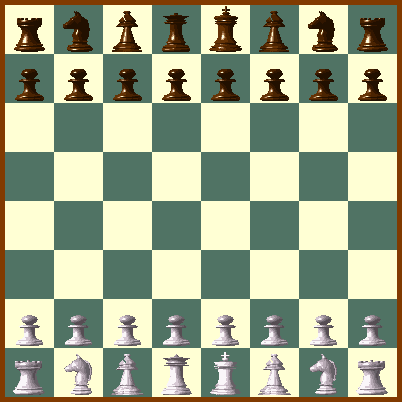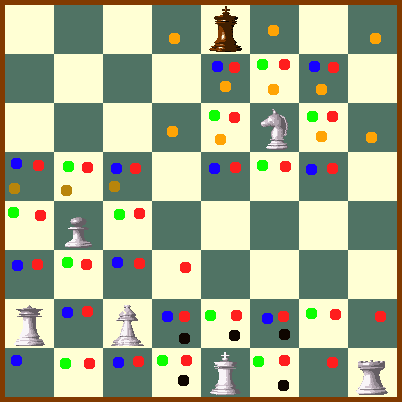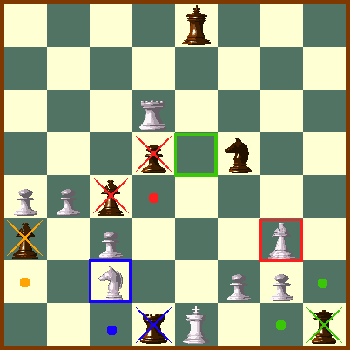Chafl
This variant attempts to combine Chess with Tafl. It adopts the Tafl method of capture as well as that game's "reaching safety" way of winning.Unlike Tafl both sides have identical armies consisting of a King, 2 Princes, a General, 2 Captains, 8 divisions of Foot, and 2 brigades of Horse.
The King and the fighting units (Foot and Horse) move by stepping or leaping while the command units (Princes, General and Captains) move by "joining" other units.
Setup

Chafl can be played with an ordinary FIDE chess board and pieces. The chess King is the chafl King; the Queen is the General; the Bishops are the Princes; and Rooks the Captains. The Pawns are the units of Foot while the Knights sre the units of Horse. As can be seen above, the starting array looks exactly the same as the start of a FIDE chess game.
Pieces
| Chafl
Name |
FIDE
Piece |
Descriptiom |
|
| King |
King |
Moves 1-step horizontally or
diagonally in any direction. Possible moves are showm in the
graphic by a black
dot. There is no castling. |
 |
| General |
Queen |
May join a friendly unit by occupying any empty square immediately adjacent to that unit. Possible moves are showm in the graphic by a red dot. | |
| Prince |
Bishop |
May join a friendly unit by occupying an empty square, of the same colour as its cuurent square, that is immediately adjacent to that unit. Possible moves are showm in the graphic by a green dot. | |
| Captain |
Rook |
May join a friendly unit by occupying an empty square, of the opposite colour to its cuurent square, that is immediately adjacent to that unit. Possible moves are showm in the graphic by a blue dot. | |
| Horse |
Knight |
Moves 1-step or Leaps 2-steps in
a straight line diagonally or horizontally, but forward or sideways
only.  Possible moves are shown by an orange dot.Â
Promotes to a General upon moving onto the farmost rank (rank 8 for
White; rank 1 for Black) |
|
| Foot |
Pawn |
Moves 1-step diagonally or horizontally foward. Possible moves are shown by a brown dot. Promotes to a Horse or Captain upon moving onto the farmost rank (rank 8 for White; rank 1 for Black) | |
Rules
There are two sides designated White and Black. Each moves a
piece in turn with White having the first turn.
A player wins by:
- Capturing the enemy King.
- Occupying a Haven with their King.
- Occupying a Haven with one of their Princes..
Capture
Chafle uses the custodian capture where a piece is captured when it has two opposite edge-adjacent squares occupied by enemy pieces as a result of an enemy move. For a piece on one of the corner squares (a1,h1,a8,h8) a capture occurs if just one of the edge-adjacent squares becomes occupied by an enemy piece. The capture rules are illustrated below.
 |
In the image on the left it is white's turn to move. 1. The Prince at g3 (red border) can move to d4 (red dot), capturing the Foot unit on d5 and the Prince on c4 (red X's). 2. The Prince at g3 can also move without being captured to e5 (green border). 3. The Prince at g3 could also move to either g1 or h2 (green dot), capturing the General at h1 (green X). 4. The Horse at c2 (blue border) can move to c1 (blue dot), capturing the Captain at d1 (blue X). 5. The Horse at c2 can also move to a2 (orange dot), capturing the Prince at a3 (orange X). |
Notes
- Although Chafl looks to Chess and Tafl for its antecedents, in
play it feels like neither. This is probably in part due to the
use of the "joining" method
of moving employed by the General, Captains and Princes. The idea
for this type of move came from my involvement in wargames where some
rule-sets allow for commands to be carried to units by messengers.
- I originally intended to use the FIDE chess names as the names of the pieces, but in the end thought it better to assign new names in recognition of the different moves for all but the King, which is the only piece that retains its FIDE name.
- Strategy appears to follow a 3-phase plan. In the initial phase the struggle is to gain control of a corner area, with the horse moving rapidly forward to form a platform for the Captains and General. The second phase sees attempts to win by placing a Prince on a Haven. In the final phase, with fewer pieces on the board and with the Princes gone, the King can try and make it safely to a Haven.
- Using ZoG I played a series of 20 computer-v-computer games, which gave the following data:
- Average moves per game = 66
- Fewest moves = 28
- Most moves = 113
- Wins by White = 12
- Wins by capturing the King = 0
- Wins by Prince on Haven = 8
- Wins by King on Haven = 10
- Drawn Games = 2
 This 'user submitted' page is a collaboration between the posting user and the Chess Variant Pages. Registered contributors to the Chess Variant Pages have the ability to post their own works, subject to review and editing by the Chess Variant Pages Editorial Staff.
This 'user submitted' page is a collaboration between the posting user and the Chess Variant Pages. Registered contributors to the Chess Variant Pages have the ability to post their own works, subject to review and editing by the Chess Variant Pages Editorial Staff.
By Graeme C Neatham.
Web page created: 2009-10-16. Web page last updated: 2009-10-16